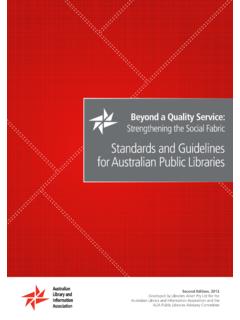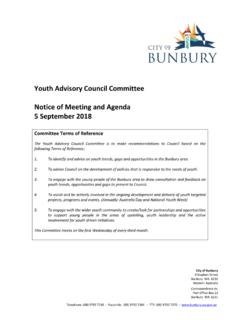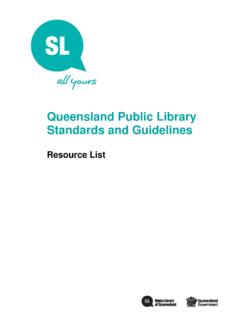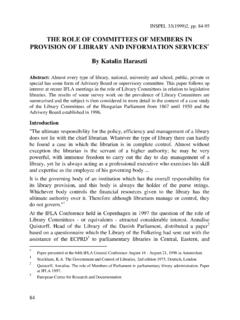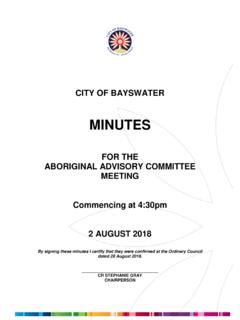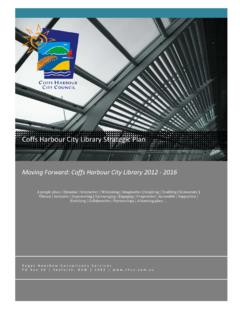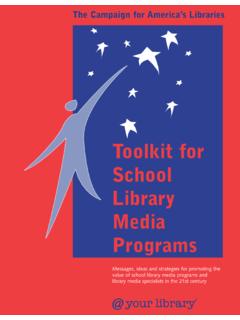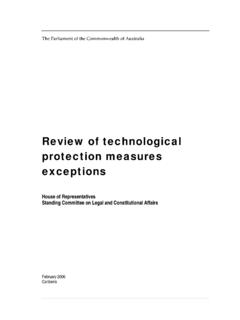Transcription of A User’s Guide - digital.org.au
1 11 Section 200AB of the Copyright Act 1968 (Cth)to the Flexible Dealing Provision for Libraries, Educational Institutions and Cultural InstitutionsA User s Guide2 Published by the Australian Libraries Copyright Committee and the Australian Digital Alliance with the assistance of the National Library of Australia, by Laura work is licensed under a Creative Commons Attribution-Noncommercial-Share Alike Australia. To view a copy of this licence, visit or send a letter to Creative Commons Australia, c/- Law Faculty, Queensland University of Technology, GPO Box 2434, Brisbane Qld 4001 Digital Alliance The ADA is a non-profi t coalition of public and private-sector interests formed to promote balanced copyright law and provide an effective voice for a public interest perspective in the copyright debate.
2 ADA members include universities, schools, galleries, museums, ICT companies and other research organisations, libraries and individuals. For further information on our objectives and the work we do, visit PO Box E202, Kingston ACT 2604, AustraliaT: 02 6262 1273 F: 02 6273 2545 ABN: 91 256 931 758 Australian Libraries Copyright CommitteeThe ALCC is the main consultative body and policy forum for the discussion of copyright issues affecting Australian libraries and archives. It is a cross-sectoral committee with representatives from national and state libraries and archives, as well as peak library and archive bodies.
3 For further information on our objectives and the work we do, visit PO Box E202, Kingston ACT 2604, AustraliaT: 02 6262 1273 F: 02 6273 2545 ABN: 51 611 768 743iContentsAcknowledgments ii1 Purpose and Nature of This Guide 12 Background to Section 200AB 3 Overview of Copyright Law 3 Copyright Amendment Act 2006 4 The Flexible Dealing Provision 43 Steps to Take When Deciding to Use the 7 Flexible Dealing Provision There Are No Other Exceptions Available to You 9 The Purpose of the Use 10 The Use Is Non-commercial 12 The Use Will Not Conflict with Normal Exploitation 13 The Use Will Not Unreasonably Prejudice 14 the Copyright Holder The Use Is a Special Case 154 Scenarios 17 Libraries 18 Archives and Collecting Institutions 29
4 Educational Institutions 34 Copying for People with a Disability 375 Our Patented Flexible Dealing Cheat Sheet 396 Further References 417 Section 200AB of the Copyright Act 1968 43iiAcknowledgmentsThanks to members of the Australian Libraries Copyright Committee, Australian Digital Alliance, Copyright in Cultural Institutions, and Australian Library and Information Association Intellectual Property Advisory Committee; staff of the National Library of Australia; Delia Browne from the Copyright Advisory Group of the Ministerial Council on Employment, Education, Training and Youth Affairs; and Sarah Waladan from Minter Ellison for thoughts and comments as this Guide was compiled.
5 Particular thanks go to Moyra McAllister, Paul Dalgleish, Bronwyn Dowdall, Ian McDonald, Kimberlee Weatherall and Robyn Wright for detailed feedback of draft copies of the Guide . Thanks also to the attendees of the 2007 Australian Libraries Copyright Committee copyright sessions, whose questions and examples are the basis of many of the scenarios discussed in this Guide . 11 Purpose and Nature of This GuideSection 200AB was introduced into Australian law through the Copyright Amendment Act 2006 (Cth) with the aim of providing a flexible exception to enable copyright material to be used for certain socially beneficial purposes, while remaining consistent with Australia s obligations under international copyright treaties.
6 1 Because section 200AB is an open-ended exception that uses terms drawn from international copyright treaties, some institutions may not be sure exactly how much use it allows. This publication therefore provides guidance and suggestions for institutions considering using section Guide does not, and cannot, provide legal advice or advice tailored to your particular situation. If you need to know how the law applies to a certain situation, a copyright lawyer can advise you. A number of other guides to section 200AB exist, some of which are referred to at the end of this publication.
7 For example, the Copyright Advisory Group has produced a Guide and the Australian Copyright Council has published a fact sheet and a more detailed Guide . There are differing views on a number of issues relating to section 200AB, and these are reflected in the different guides. Your organisation s management or lawyers can advise you, particularly in situations where there are differing views on a Explanatory Memorandum, Copyright Amendment Bill 2006 (Cth), Background to Section 200 ABOverview of Copyright LawCopyright law in Australia gives copyright holders exclusive rights to do certain things with their material.
8 Depending on the type of material, the copyright holder generally has the right to control: publication performance communication to the public adaptation of the material (for example, a translation or adaptation from a novel to a play) a person or institution wishes to use material under copyright in a way that can be controlled by the copyright holder (for example, making a copy), they will generally need to seek the permission of the copyright holder. Material is protected by copyright for up to 70 years after the death of the creator. Works that have been unpublished can remain in copyright in perpetuity.
9 These rights provide copyright holders with an incentive to produce works, as they are given a time period during which they can exploit the work for their own economic gain. However, it is recognised that copyright law must strike a balance between providing this incentive to create and providing users (and creators) of copyright material with reasonable access. It is particularly important that copyright law is not so restrictive that it hinders people and institutions from using copyright material for socially beneficial purposes, such as education and research. For this reason, the Copyright Act 1968 (Cth) contains a number of exceptions to copyright holders rights.
10 Where an exception applies, the individual or institution does not need to obtain the permission of the copyright holder before they use the material, and in many cases, will not need to pay a fee or royalty. Most exceptions under Australian copyright law are quite specific in nature. That is, they only apply to certain types of uses or purposes. For example, the fair dealing exceptions apply only to uses such as criticism and review, reporting the news, research and study, and parody and are also exceptions that apply to certain organisations, for example libraries, and only to certain uses within libraries, such as copying for preservation purposes.
